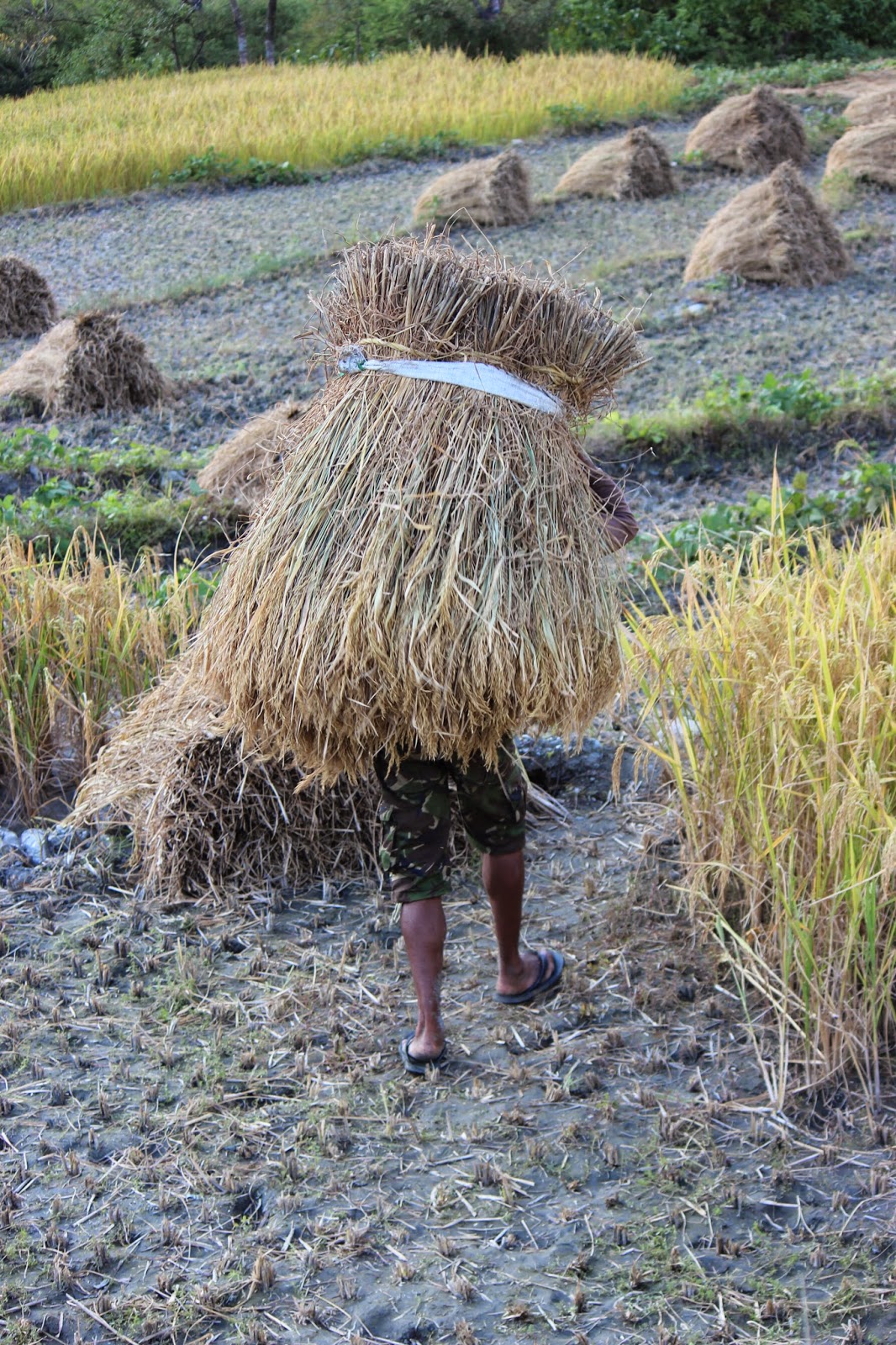After nearly four months of living in Nepal , local eating
times are still a bit of a mystery. The day starts early and one of the first
sounds to pierce the morning stillness is the hiss of pressure cookers from 4am
onwards. It is still dark and the cock soon starts its morning chorus followed
by the not so tuneful man clearing his throat across the street. Night times
have been quiet compared with the constant racket of the city, but recently we
have been woken by a horrific howling/screeching noise which sounds like
nothing we’ve heard before. Definitely not a bird noise, not even the biggest
Little Owl could produce such a din, or the mating call of a fox which can be
pretty frightening. No, this is a few more notches up the decibel scale, in
fact Frankenstein or Dracula come to mind. Whatever is causing the sound the
town dogs respond with a barrage of howls making me realise it’s not all been
part of some nightmare.
 |
| First signs of the rice harvest getting underway |
Back to the more mundane topic of meal times, and local
eating habits. This is a farming community and even the local junior school
headmaster has his milking buffalo, which he likes to gather grass for early in
the morning. Schools and many offices don’t open until 10.00 allowing employees
to do their basic stock tasks before work and again at the close of the day
since work will finish by 5.00 pm. A cup of sweet milky tea will start the day
with biscuits. Then comes the chores,
often followed by a long walk or bus ride to work. Depending upon the logistics
of the day daal baat will be eaten before 10am., and one of the common greetings
here is ‘khaanaa khaane’, ‘have you eaten. This diet of rice and lentils literally drives
Nepal along. A young man of 17 I talked to whilst visiting a local farm proudly
said his family of 5 ate a kilo of dried rice each day. At the time he was
carrying a 30kg sack of rice 2kms back from the mill and claimed to have
carried up to 60kgs. The up side is that this family only needs to grow 365kgs
of rice per year, and can sell any surplus.
 |
| A couple of colleagues at a small dairy get stuck into daal baat |
 |
| Not for the faint hearted! These men finished breakfast with a mixture of fresh lime, salt and a chopped, whole green chili. |
So to for the volunteer.
He or she may have to take a longish bus ride and then walk for between one and three hours to work at a
rural school or visit a farming community. Breakfast is an important meal but
cooking rice, daal, curries and pickles needs practice if it’s to be done under
an hour. Our answer to this starch demand is ‘Porridge’, flavoured with local honey. Oats are not available in Besisahar, other
than in expensive plastic containers. Simple rolled oats with much of the bran
still attached are available in the city at £1 per kilo. We bring these home
and store in our useful blue rodent proof containers we brought from the UK.
Water and oats are boiled and continually stirred, left for a few minutes, off
the heat, to complete their cooking and dished up. No salt needed just a large
teaspoon of local honey. The Milijuli Agricultural Cooperative where 100 women
beekeepers produce the tastiest set honey we’ve found, have asked for
advanced apiary courses to be facilitated, so that’s a happy coincidence.
 |
| Oats, water and a spoon carved by one of my sons back in the UK, and porridge is underway. |
 |
| Most pans are aluminium, as is the kettle. |
 |
| On with the honey. This time we were using another local non-set brand. Wild honey, collected high up on rock faces is available but its rich flavours take some getting used to. |
 |
| For those with a long walk to work, a sel roti and more honey are the next course. Like a doughnut this roti is a fried batter ring. Must be done in very hot oil. |
 |
| Mustang apples and black tea to finish. Yes that thermometer is reading nearly 25c at 6.30am! |
Fruit is always available in the bazar and is seasonal. At the moment apples from Mustang, our
neighbouring district, small green Nepali oranges with lots of pips but a great
flavour, and the ever present bananas fill our fruit bowl. Apples are priced
the same as UK and so are popular but expensive, whereas the oranges are about
35p per kilo. Bananas, strangely are
sold by the dozen and cost about 50p. Our in-country allowance is 21000nrs
which is based up local costs of living, and equates to £130 per month, each. We
it find to be adequate. One of our personal challenges of living the volunteers
life, is surviving and even flourishing on a far lower income. Gone is most of the meat, beer and chocolate.
And down has come or weight!!
Over the coming weeks as well as our tales of work and
everyday life we will also blog about our other culinary experiences and
include some recipes. Rick Stein look out!!!
 |
| A friendly face along the path. The scarf has many uses. Folded and worn to shade the head is one. |
 |
| More signs of harvest. Winter woollies are worn at 26c. |
 |
| That scarf being used again. |
 |
| For those who know him my brother Nick seems to have found his way out here, complete with Glastonbury headgear, locally known as a 'topi'. Needless to say I have one! |
 |
| An evening shot of Lamjung Himal, and Annapurna 2 with ripening rice in the foreground. |










































